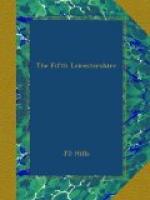Motor lorries took us on to the main Amiens road at Corbie, and turning East along it we jolted and bumped and splashed our way through Brie-sur-Somme to Tertry. The country—what we could see of it in the dark—seemed to consist of a barren waste of shell holes with here and there a shattered tree or the remains of some burnt-out Tank standing forlornly near some dark and stagnant swamp. Villages were practically non-existent, and Tertry was no exception, but we soon settled down under waterproof sheets, corrugated iron and a few old bricks. The transport under Major Burnett and Serjt. Yeabsley came all the way by road, and arrived some hours later; but much of our stores had to be left behind with two storemen in Buire. Many efforts were made during the following months to retrieve these stores, but it was not until after the armistice that we were finally successful.
We were now IXth. Corps, and found our neighbours were old friends from the Bethune area—the 1st and 6th Divisions. The Transport lines and “battle details” of the 1st and 11th Battalions of the Regiment were quite close to us, and we paid several calls. On the 20th, Captains Tomson and Banwell returned from leave, much to the delight of their Companies, for the following day we went into trenches, relieving the 14th and 45th Australians in the Hindenburg Outpost line, that they had so brilliantly captured a few days before. We were in Brigade support along Ascension Ridge, called after a farm of that name, and the other two Battalions held the line in front of us.
In their attack, the Australians had pushed forward further than anyone else, while the English troops on their right, after some very hard fighting, had been held up by the village of Pontruet. Consequently there was a sharp bend in the line, and the Australian right flank, though on high ground, was somewhat exposed. The line ran roughly as follows:—
[Illustration: Sketch of the line at Pontruet.]
The enemy still held posts on the ridge close to the Australian front line, and were known to have several posts in Forgan’s trench, which was the Southward continuation of our front line across the valley. Pontruet was overlooked from everywhere, and constantly bombarded by our Artillery, so it did not seem likely that it held many Boche. The Sherwood Foresters held the right of the Divisional line and joined with the 1st Division on the high ground South of the village. There was no sign of any intended operation, and it certainly looked as if we could not move until the troops on our right had advanced. Accordingly on the 22nd the Adjutant rode back to Brie to go on leave. Capt. Banwell, really a “battle detail,” went up to assist the Headquarters, while the other “details”—Major Burnett, Captain Petch, Lieut. Pierrepont, 2nd Lieuts. Edwardes, Griffiths, Taylor, C.S.M.’s Cooper and Martin—remained with the Q.M. Stores.




